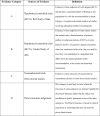Difficult-to-control asthma management through the use of a specific protocol
- PMID: 21049219
- PMCID: PMC2954742
- DOI: 10.1590/s1807-59322010000900014
Difficult-to-control asthma management through the use of a specific protocol
Abstract
The present study is a critical review of difficult-to-control asthma, highlighting the characteristics and severity of the disease. It also presents a protocol for the management of patients with this asthma phenotype. The protocol, which was based on relevant studies in the literature, is described and analyzed.
Figures











Similar articles
-
[Treatment of chronic persistent severe asthma: role of methotrexate].Med Clin (Barc). 1993 Mar 13;100(10):384-8. Med Clin (Barc). 1993. PMID: 8474283 Review. Spanish. No abstract available.
-
Weekly low-dose methotrexate for reduction of Global Initiative for Asthma Step 5 treatment in severe refractory asthma: study protocol for a randomized controlled trial.Trials. 2014 Dec 18;15:492. doi: 10.1186/1745-6215-15-492. Trials. 2014. PMID: 25523634 Free PMC article. Clinical Trial.
-
New concepts in treatment of chronic persistent asthma. Using a stepwise protocol to control inflammation.Postgrad Med. 1991 Sep 1;90(3):81-4, 89-90. doi: 10.1080/00325481.1991.11701034. Postgrad Med. 1991. PMID: 1881860 Review.
-
Asthma Phenotypes; Do They Matter?Arch Bronconeumol. 2017 Apr;53(4):177-179. doi: 10.1016/j.arbres.2016.11.016. Epub 2017 Jan 23. Arch Bronconeumol. 2017. PMID: 28126200 English, Spanish. No abstract available.
-
More than a decade follow-up in patients with severe or difficult-to-treat asthma: The Epidemiology and Natural History of Asthma: Outcomes and Treatment Regimens (TENOR) II.J Allergy Clin Immunol. 2018 May;141(5):1590-1597.e9. doi: 10.1016/j.jaci.2017.07.014. Epub 2017 Aug 7. J Allergy Clin Immunol. 2018. PMID: 28797732
Cited by
-
Current opinions for the management of asthma associated with ear, nose and throat comorbidities.Eur Respir Rev. 2018 Nov 21;27(150):180056. doi: 10.1183/16000617.0056-2018. Print 2018 Dec 31. Eur Respir Rev. 2018. PMID: 30463872 Free PMC article. Review.
-
Breathing exercises for adults with asthma.Cochrane Database Syst Rev. 2020 Mar 25;3(3):CD001277. doi: 10.1002/14651858.CD001277.pub4. Cochrane Database Syst Rev. 2020. PMID: 32212422 Free PMC article.
-
Respiratory exercise program for elderly individuals with asthma.Clinics (Sao Paulo). 2011;66(7):1163-9. doi: 10.1590/s1807-59322011000700007. Clinics (Sao Paulo). 2011. PMID: 21876968 Free PMC article.
-
United airway disease: current perspectives.J Asthma Allergy. 2016 May 11;9:93-100. doi: 10.2147/JAA.S81541. eCollection 2016. J Asthma Allergy. 2016. PMID: 27257389 Free PMC article. Review.
-
Patterns of heart rate variability and cardiac autonomic modulations in controlled and uncontrolled asthmatic patients.BMC Pulm Med. 2015 Oct 12;15:119. doi: 10.1186/s12890-015-0118-8. BMC Pulm Med. 2015. PMID: 26459382 Free PMC article.
References
-
- GINA. The Global Initiative for Asthma. Disponível em: www.ginasthma.com.
-
- Moorman JE, Rudd RA, Johnson CA, King M, Minor P, Bailey C, et al. National surveillance for asthma – United States, 1980‐2004. MMWR Surveill Summ. 2007;56:1–54. - PubMed
-
- Strachan DP. Hay fever, hygiene, and household size. BMJ. 1989;299:1259–60. 10.1136/bmj.299.6710.1259 - DOI - PMC - PubMed
-
- Anderson HR, Gupta R, Strachan DP, Limb ES. 50 years of asthma: UK trends from 1955 to 2004. Thorax. 2007;62:85–90. 10.1136/thx.2006.066407 - DOI - PMC - PubMed
-
- Solé D, Yamada E, Vana AT, Costa‐Carvalho BT, Naspitz CK. Prevalence of asthma and related symptoms in school‐age children in São Paulo, Brazil – International Study of Asthma and Allergies in Children (ISAAC) J Asthma. 1999;36:205–12. 10.3109/02770909909056318 - DOI - PubMed
Publication types
MeSH terms
LinkOut - more resources
Full Text Sources
Medical

